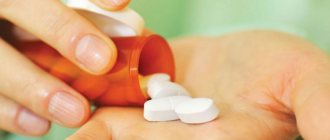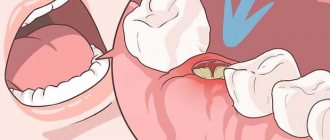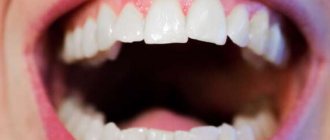Content:
- The use of antibiotics during tooth extraction for preventive purposes
- Antibiotics after tooth extraction with inflamed gums
- When you can't do without antibiotics
- Types of antibiotics used in dentistry
- What are the consequences of not taking antibiotics?
Only the dentist can decide whether to prescribe an antibacterial drug to a patient or not.
The need for its use does not always arise. If the operation was uncomplicated and the likelihood of complications is minimal, additional drug therapy is usually not required. Even if after tearing out a unit the body temperature has increased, this is not an indication for antibiotic therapy. The body adequately responds to the inflammatory process and does everything necessary to block the spread of pathogenic microflora. Normally, already on the 3-4th day the patient’s condition is completely normalized, the pain goes away, the swelling subsides.
Specifics of flux therapy
Self-exposure to the affected area with antibiotics does not make logical sense - in one case out of a hundred, the patient correctly guesses the required drug. When visiting a medical facility, the patient undergoes a full diagnostic examination, which allows one to determine the type of pathogen that has penetrated and its level of resistance to medications.
During the examination, the dentist will accurately determine the problem tooth that caused the formation of the inflammatory process, the need for sanitation of the oral cavity (treatment of carious surfaces) and only after all the procedures will he prescribe a treatment regimen.
Purulent lesions that form near the apex of the tooth root are most often caused by staphylococcal or streptococcal infections. Even without carrying out the necessary diagnostics, experienced specialists will recommend that the patient adhere to the following rules:
- the total time of therapeutic effect cannot exceed two weeks, a smaller number of days is determined by the severity of the pathological process;
- flux detected in the initial stages can be treated conservatively with medications;
- pathology recorded in advanced stages requires surgical intervention.
The presence of constant toothache indicates the development of pathological abnormalities that cannot be cured on your own. In any scenario, a visit to a dentist will take place. Experts recommend avoiding self-medication with the “best” antibiotics recommended by neighbors and work colleagues.
The drug Amoxiclav is one of the most commonly used drugs in the practical work of surgical dentists. The positive quality of the medication is its tolerability and the minimum number of adverse reactions of the body.
Use during pregnancy and lactation is not prohibited by the manufacturer; there is only a limitation on permissible dosages. If the requirements of the instructions attached to the pharmacological substance and the advice of the attending physician are correctly followed, the drug will act in a short time. The high effectiveness of the drug allows it to be considered one of the main drugs for the treatment of inflammatory and other pathological processes in the oral cavity.
Sources used:
- Medicines in dentistry. Directory / L.N. Maksimovskaya, P.I. Roshchina. — M.: Medicine
- Rational pharmacotherapy in dentistry. — M.: Litterra
- National Library of Medicine (USA)
- The use of non-steroidal anti-inflammatory drugs for the treatment of dental diseases / S.T. Sokhov et al. - M.: MEDpress-inform, 2011.
Antibiotics after tooth extraction with inflamed gums
A few days after the extraction, the patient visits the dentist who performs the operation. The doctor assesses the course of regenerative processes. If it turns out that the inflammatory process has spread and there is a high probability of a bacterial infection, then antibiotics are immediately prescribed. They create conditions for the speedy restoration of damaged mucous membranes.
The most common reasons why antibiotic therapy is necessary after removal of radical units:
- non-compliance with medical prescriptions, due to which the hole became inflamed;
- too active rinsing of the mouth, which caused the displacement of the protective blood clot;
- slow healing associated with the individual characteristics of the human body.
After studying the specifics of the situation, the doctor decides which medications to prescribe. In some cases, it is possible to get by with local application of antibacterial gels and ointments. For severe inflammation, oral medications are prescribed.
The effect of surgery on the human body
No matter how progressive modern dentistry is, installing an implant is still a complex and quite traumatic procedure. During it, the structure of soft and hard tissues is damaged, which requires a long period of rehabilitation. Pathogenic bacteria can enter the wound resulting from a puncture or cut, which can lead to the development of inflammation and even rejection of the implanted pin.
After surgery, a person often experiences severe pain, swelling and redness of the mucous membrane. This is a completely adequate reaction of the body, however, there are methods to reduce the severity of these symptoms. This is why the doctor prescribes painkillers and antihistamines.
Unfortunately, simple analgesics are powerless against infection and germs. Baths for rinsing the mouth are also indispensable here. Therefore, prescriptions always contain a powerful antibiotic. A properly selected course of therapy helps to avoid many unpleasant consequences and get a guaranteed result.
When you can't do without antibiotics
If after extraction a secondary inflammatory process has developed, affecting the trigeminal nerve, alveolar ridge, periosteum, there is nowhere without antibiotic therapy. It is also carried out if:
- the operation was complex (for example, the “eight” was pulled out);
- a large amount of purulent exudate is released from the hole;
- alveolitis has developed, body temperature is elevated, the wound is infected;
- periodontitis was diagnosed, spreading to the tissues that are located next to the extracted tooth;
- osteomyelitis was identified, which contributes to the formation of fistulas;
- periostitis progresses, has spread to the periosteum;
- After the operation, flux developed at the removal site, and the face became very swollen.
It is very important that in case of any complications the patient visits the dental clinic and does not self-medicate, experimenting with different pharmaceutical drugs and folk recipes.
Fibrosing alveolitis
This type of pathology is notable for the fact that connective tissue develops to replace the necrotic residue of the hole left after tooth extraction. In principle, many dentists propose to consider fibrosing alveolitis not as a separate type of this nosology, but as one of the stages of its course, which is characterized by a slight decrease in the intensity of the manifestations of the inflammatory reaction and partial stabilization of the general condition of the patient. If you take a closer look at the condition of the oral cavity, you will notice a slight proliferation of soft tissues adjacent to the hole in which the pathological process occurs. The formation of a gap between the soft tissues and the hard, bone wall is also typical in this situation.
Types of antibiotics used in dentistry
To eliminate the symptoms and consequences of dental diseases, antibiotics of the following pharmacological groups can be used:
- Penicillins. The largest category of antibacterial agents. They are characterized by a wide spectrum of action and effectively destroy pathogenic microorganisms. They can be injected or used in tablet form.
- Macrolides. Remedies that are often used for diseases of the ENT organs. Dentists prescribe them only if the patient has poor tolerance to other antibacterial drugs or the pathogen is insensitive to penicillins.
- Cephalosporins. Medicines exhibiting excellent bactericidal properties. In dental practice, two representatives of the group are most often used - Cefaclor and Cephalexin.
- Lincosamides. Medicines that effectively control the inflammatory process. With their help, you can quickly eliminate inflammation and prevent further progression of dental complications. A popular representative of lincosamides is Lincomycin. It can be bought in the form of tablets, injections, ointments. The latter is suitable for tamponade of the inflamed socket.
- Fluoroquinols. Contains tsifran - a component that quickly destroys pathogenic flora. Indicated for purulent complications.
- Aminoglycosides. They are prescribed after extensive dental operations, if the wound is infected or the infection has entered the blood.
- Tetracyclines. They act by blocking protein synthesis in microbial cells. These include Oletetrin, Doxycycline. It should be noted that today tetracyclines are used less and less, since many modern infections are little sensitive to their active substance.
Amoksiklav®
Before starting treatment, it is necessary to interview the patient to identify a history of hypersensitivity reactions to penicillins, cephalosporins or other beta-lactam antibiotics. In patients who are hypersensitive to penicillins, cross-allergic reactions with cephalosporin antibiotics are possible.
Serious and sometimes fatal hypersensitivity reactions (anaphylactic as well as severe skin adverse reactions) to penicillins have been described. The risk of such reactions is highest in patients with a history of hypersensitivity reactions to penicillins, as well as atopy. If allergic reactions occur, treatment with the drug should be discontinued and appropriate alternative therapy should be initiated.
If the infection is proven to be caused by microorganisms sensitive to amoxicillin, the advisability of switching from amoxicillin/clavulanic acid to amoxicillin should be considered.
During a course of treatment, it is necessary to monitor the state of the function of the hematopoietic organs, liver, and kidneys. In patients with impaired renal function, the dose should be adjusted according to the degree of impairment.
In order to reduce the risk of developing side effects from the gastrointestinal tract, the drug should be taken at the beginning of a meal.
In patients receiving a combination of amoxicillin and clavulanic acid together with indirect (oral) anticoagulants, an increase in prothrombin time has been reported in rare cases. When co-prescribing indirect (oral) anticoagulants with a combination of amoxicillin and clavulanic acid, monitoring of relevant indicators is necessary. To maintain the desired effect of oral anticoagulants, their dose may require adjustment.
In some cases, prolonged use may lead to overgrowth of non-susceptible microorganisms. Superinfection may develop due to the growth of microflora insensitive to amoxicillin, which requires a corresponding change in antibacterial therapy.
In patients with impaired renal function, as well as when taking high doses of the drug, seizures may occur.
If infectious mononucleosis is suspected, the drug should not be used, since amoxicillin can cause a measles-like skin rash in patients with this disease, which makes diagnosing the disease difficult.
Taking allopurinol during treatment with amoxicillin may increase the likelihood of allergic skin reactions.
The appearance at the beginning of treatment of generalized erythema with pustules, accompanied by an increase in body temperature, may be a symptom of acute generalized exanthematous pustulosis. If such a reaction occurs, you should stop taking the drug and refuse further therapy with amoxicillin.
Amoxiclav® should be used with caution in patients with signs of liver failure.
Hepatic side effects were observed predominantly in men and elderly patients and may be associated with prolonged treatment. In children, these phenomena were observed very rarely. In all groups of patients, signs and symptoms usually appear during or shortly after the end of treatment, but in some cases they may appear several weeks after the end of treatment. They are usually reversible. Liver side effects can be severe, and deaths have been reported very rarely. In almost all cases, they were observed in patients with a severe underlying disease or during the simultaneous use of other drugs that can affect the liver.
Antibiotic-associated colitis has been observed during therapy with almost all antibacterial drugs, including amoxicillin, and the severity can range from mild to life-threatening. Therefore, it is important to consider this diagnosis in patients with diarrhea that occurs during or after administration of any of the antibiotics. If antibiotic-associated colitis develops, Amoxiclav® should be immediately discontinued, consult a doctor and begin appropriate treatment. In this situation, drugs that inhibit intestinal motility are contraindicated.
Crystalluria very rarely occurs in patients with reduced diuresis. During the use of large doses of amoxicillin, it is recommended to take sufficient fluids and maintain adequate diuresis to reduce the likelihood of amoxicillin crystal formation.
In patients with a catheterized bladder, regular checks of catheter patency are necessary.
Lab tests
: High concentrations of amoxicillin give a false-positive reaction to urine glucose when using Benedict's reagent or Fehling's solution.
It is recommended to use enzymatic reactions with glucosidase.
Clavulanic acid may cause nonspecific binding of immunoglobulin G (IgG) and albumin to red blood cell membranes, resulting in false-positive Coombs test results.
There have been cases of positive test results using the Bio-Rad Laboratories Platelia Aspergillus enzyme immunoassay in patients receiving amoxicillin/clavulanic acid who were subsequently free of Aspergillus
. Cross-reactions with non-Aspergillus polysaccharides and polyfuranoses have been reported using the Platelia Aspergillus test. Therefore, caution should be used when interpreting positive test results in patients receiving amoxicillin/clavulanic acid, and they should also be confirmed using other diagnostic methods.
What are the consequences of not taking antibiotics?
If a doctor has prescribed a medicine, but the patient does not want to take it because of some personal beliefs, the situation often turns against him. It may turn out that the doctor’s worst fears will come true - the inflammatory process will spread to the jaw bone. Then osteomyelitis will develop.
This purulent disease is quite insidious. It can affect internal organs and cause sepsis, which, in turn, can be fatal. Therefore, you should not argue with the dental surgeon and ignore his appointments. Take care of your health.
Treatment of alveolitis
Treatment of alveolitis, regardless of its etiology, is a very difficult task, the solution of which clearly requires professional medical care. In no case should you act independently and at home, because with an illiterate approach there is a high chance of causing significant harm.
Conditionally, the treatment of alveolitis can be classified into stages - depending on how timely the alveolitis was diagnosed, the treatment and general management tactics are determined.
Early treatment
If alveolitis was diagnosed in the initial stages, then to get rid of the disease it is sufficient to perform the following measures:
- The implementation of drug anesthesia is primarily because, despite its relative simplicity, the process of getting rid of alveolitis is quite painful.
- Treatment of the hole in which there is an inflammatory process is washed with an antiseptic solution.
- Removing necrotic debris from the socket.
- Repeated treatment of the hole with an antiseptic followed by drying with gauze.
- Placement on top of fabric soaked in antiseptic and drugs that provide an anesthetic effect.
- Apply applications with antiseptics daily (for a week) in order to eliminate the possibility of a relapse of the inflammatory reaction.










